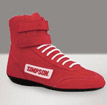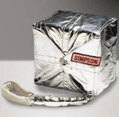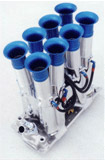



DRAG RACING LINGO
Aftermarket - Generally the replacement parts and high performance products in the market. The design and selling of custom parts for automobiles.
Air Dam - used to direct or block air flow. Used in front to prevent air flow to undercarriage. Intended to prevent turbulence and lift.
Air Foil (Stabilizer ) - Generally used to create down forces, increasing stability and tyre to track adherence at high speeds
ANDRA - Australian National Drag Racing Association, the sports sanctioning body in Australia.
Arm Restraints - Restraining straps to restrict arm movement in a car accident.
Ballast - A controlled amount of weight, functionally positioned, used to help car meet class weight requirements.
Belly Pan - Generally, a skin of aluminium or fibreglass used to cover the under carriage of vehicle, assisting in preventing turbulence and air drag.
Blueprinting - The meticulous matching to factory specifications all parts and/or components. Dressing parts to absolute design callout or manufacturer's specifications.
Bleach Box - Section of track before the starting line where cars spin the tyres in water.
| Boots - Driving boots worn by drivers made of fire protective materials. |  |
Breakout - (Run under) When your elapsed time is quicker than your dial-in, causes you to be disqualified.
Burned Piston - When a cylinder runs lean (too much air in the air-to-fuel mixture) and excessive heat burns or melts the piston.
| Burn-out - Spinning of rear wheels at high RPM in water to heat and clean drive tyre rubber prior to a run, resulting in increased traction. |  |
Burst Panel - A section of the front of a supercharger intake manifold designed to relieve pressure and minimize the effects of a supercharger explosion or backfire.
Bye Run - A lone run given to a car because of an unequal number of cars in the round.
C.C - Cubic centimetre, a metric unit of volume measurement, equal to approximately 0.061 cubic inch.
C.F.M. - Cubic feet per minute. A measure of volume.
C.I.D. - Cubic inch displacement. A measure of volume.
Camber - Tilting of the top of the wheels from the vertical. When tilt is outward, camber is positive.
Caster - Tilting of steering axis forward or backward to provide directional steering ability. Positive caster recommended for drag racing.
Catch-can - A container used to catch liquid overflow, preventing spillage on race track. Also known as catch-tank.
Chassis - The frame of the race car.
| Christmas Tree - An electronic starting device incorporating calibrated lights displaying a visual countdown for each driver, activated by a designated official. |  |
Chromoly - Also Chrome Moly, short for Chromium Molybdenum steel. A very strong and light tubing highly adaptable for race cars.
| Chute - Short for parachute or drag chute. Used to assist high-speed braking. |  |
Clutch can - Bell housing, the bell-shaped housing used to encase clutch and flywheel.
Clutch dust - Carbon dust created by the wearing of the surface of the clutch disks as they slide together during the clutch lock-up process.
Clutch lockup - The progression of the clutch-disc engagement controlled by an air-timer management system.
Competition Area - The staging lanes and race track surface.
Corrected altitude - Result of factoring barometric pressure, humidity, temperature and grains of water per pound of air to provide a theoretical altitude. Information is used to race vehicle tuning purposes.
Deep staged - A driver is deep staged when, after staging, he or she rolls a few inches farther, which causes the pre-stage light to go out. In that position, the driver is closer to the finish line but dangerously close to a foul start.
Dial-in - Driver's predictions of E.T.'s their cars will run in the elimination.
Diaper - A blanket made from ballistic and absorbent material, often Kevlar, which surrounds the oil pan and serves as a containment device during engine explosions.
| Disc - In brakes, the rotor, the part which revolves, and against which brake linings are pressed to provide braking. |  |
Displacement - In an engine, the total volume of air/fuel mixture an engine is theoretically capable of drawing into all cylinders during one operating cycle.
Doorslammer - A race vehicle with opening doors. See also Top Doorslammer.
Down force - Vertical aerodynamic downloading which aids a race car in achieving traction.
| Driver's suit - generally, protective fire-resistant materials. |  |
Dropped cylinder - A cylinder becomes filled with too much fuel in the air-to-fuel mixture and prevents the spark plug(s) from firing.
Dry Hops - Process of spinning your tyres on dry pavement on the start line.
Dynamometer - A stationary device used to measure an engine's torque to determine horsepower.
ET - Elapsed time. The total time it takes for a vehicle to cover the standing quarter mile from starting line to finish line. Measured from the time the vehicle moves off the start line, not when the green light comes on.
Eliminations - When cars are racing two at a time in tournament-style competition, resulting in one winner and one runner-up in each category of racing.
F.I.A. - International Federation of Automobile Clubs. Sole international body governing motoring sport.
Ferrous - Containing iron, as in metals.
Fishtail - Aft lateral oscillation, generally the result of traction loss.
Final MPH light beam - Light beam to shut off elapsed time computer and signals win indicator and elapsed time.
Finish Line light beam - Light beam to shut off elapsed time computer and signals win indicator and elapsed time.
Fire Bottle - Fire extinguishers in various positions on different cars. These bottles contain fire retardant and are activated by the driver in the event of a fire.
First MPH light beam - Light beam to start MPH computer.
Flash shield - A device to encompass the air inlet of a carburettor's sides, top, rear. To protect driver in case of engine backfire.
Foul Start - Leaving the staging line before the green light starting signal.
Fuel Check - A inspection of fuels to insure content is within limits allowed for that particular class. Analysis of fuel.
| Fuel Injection - A system replacing conventional carburetion which delivers fuel under pressure into combustion chamber of air flow prior to entering chamber. |  |
Full Tree - The consecutive appearance of all three amber lights on the Christmas tree four-tenths of a second apart, followed four-tenths later by the green starting light. A perfect reaction time on a full tree is .000.
Gilmer belt - Toothed or splined drive belt used with matching pulley, generally a non-slip drive belt.
| Gloves - Worn by the driver, made from protective fire-resistant materials. |  |
Guard Beam - Light beam to alert officials if driver starts to race before the green light appears. Often called a foul start.
Gusset - A reinforcement addition adding web-like or triangulation reinforcement to car structure, usually welded in place.
Halon - Special Freon Fire Extinguisher. Generally a 3 % to 5 % concentration will extinguish fire.
Handicap - When one car is faster than the other, the slower gets a head start. Head start depends on previous elapsed times or dial ins.
Headers - Fine-tuned exhaust system routing exhaust from engine. Replaces conventional exhaust manifolds.
Heads-up - A race in which both vehicles receive the green start light at the same time and can leave the start line together.
| Helmet - Worn by the driver for head protection. |  |
Hemi - Generally an engine with a combustion chamber having resemblance to a hemi-sphere or round ball, cut in half. Spark plugs are also located in centre of head, not to one side.
Hole shot - Starting line advantage achieved by the quicker reacting driver.
Horsepower - Numeric value given to the amount of power produced by an engine.
Hydralic - When a cylinder fills with too much fuel, thus prohibiting compression by the cylinder and causing a mechanical malfunction, usually an explosive one.
Index - Elapsed time assigned by the racing sanctioning association to allow various classes to race together with an equitable handicap starting system.
Inline - Cylinders in a single row, valve stems in a single row.
Interval timers - Interval timers are part of a secondary timing system that records elapsed times, primarily for the racers benefit, at 60, 330, 660, and 1000 feet from the start line.
Ladder Bars - A 3-point traction device with 2 attaching points at rear axle housing and 1 point at frame.
Length of Track - 1320 feet, ¼ mile distance from start to finish, or sometimes at 660 feet from the start line.
Lexan - A trade name of General Electric used for a durable thermal resistant plastic material used where transparent material is required ( i.e. , face plates, goggles, windows, etc).
Line-Lock - A lock on the front brakes to allow a car to do a burnout, as well as remain still on the start line prior to the launch of a run.
M.I.G. - Metal Insert Gas Arc welding. Uses a continuous-feed filler rod material pulled through the torch from a roll of wire.
M.P.H. - Miles per hour.
Magnaflux - The process of using a special electromagnet and magnetic powder to detect cracks in iron which may be invisible to the naked eye.
Methanol - Technically pure methyl alcohol CH3oh(toxic) produced by synthesis.
Minimum weight - The lowest allowed weight for the vehicle in it's class.
Nappy - A blanket made from ballistic and absorbent material (often Kevlar) that surrounds the oil pan and serves as a containment device during engine explosions.
Nitro methane - A fuel produced specifically for drag racing. It is the result of a chemical reaction between nitric acid and propane.
Nomex - Trade name of DuPont, a fire-resistant fabric used in the manufacture of protective clothing.
O.E. - Original Equipment (as originally produced and installed by factory manufacturing automobile.) originally equipped.
O.E.M. - Original Equipment Manufacturer. Original Automobile Manufacturer.
O.H.C. - Overhead Cam.
| On board data recorder - Electronic recording device that provides specific performance data following a run. The data recorder cannot be used to control race car functions during a run. |  |
Otto Cycle - The four operations of intake, compression, power, and exhaust(4-cycle engine). Named for inventor Dr. Nikolaus Otto.
Pedalling - When a driver lifts off the throttle, then gets back on it again, in an attempt to regain traction with the rear tyres.
Permanent - Pre-assigned, registered competition numbers assigned by the Drag racing sanctioning association.
Pilot Chute - A spring-loaded device which pulls the braking chute from its pack.
Pits - Where the race cars are parked when been worked on.
Pre-staged light Beam - Light beam used to warn drivers they are inches away from starting line. This beam when broken by front wheels sets off pre-staged bulb on top of the Christmas Tree.
Planetary Transmission - A transmission in which the various gears revolve around one another. Consists of a sun gear, carrier with planet gears and ring gears. Also known as overdrive or underdrive.
Port - The opening in an engine where the valve operates and through which the air-fuel mixture or exhaust passes.
Protest - A complaint filed against a competitor, investigated by officials.
Pro-Tree - The method of starting cars from starting line, using the Christmas tree. Method used is all three yellow bulbs light then green as opposed to one yellow light at a time then green(full tree). Also uses a reaction time of .000.
R.P.M. - Revolutions per minute.
Rake - Bottom of body not parallel to ground (lower in front).
Reaction Time - Computed in thousandths of a second and is the time how quickly you moved off the starting line after the go signal.
Return Road - Road which leads from shutdown area back to the pits or staging lanes.
Roll cage - Reinforced steel compartment that encloses the driver in the car.
Rollout - The measurement of one complete revolution of a tyre. Rollout equals 3.14 times the tyre's diameter.
Round - When all cars in a bracket (class) have made a run.
Scales - Used to weight cars to assure that they meet class weight requirements.
Seating the clutch - The process of loading the clutch pack to allow the clutch discs and floaters to properly align with each other before a run.
Shift light - A light activated on the dash when it is necessary for the driver to shift gears.
| Shoulder harness - An upper-torso restraint device. |  |
Shutdown Area - Area located after finish line for racing cars to slowdown.
Sixty-foot time - The time it takes a vehicle to cover the first 60 feet of the race track. It is the most accurate measure of the launch from the starting line, which in most cases determines how quick the rest of the run will be.
Slider clutch - A multi-disc clutch designed to slip until a predetermined RPM. Decreases shock load to the drive wheels.
Speed Trap - The final 66 feet to the finish line, known as the speed trap, where speed is recorded.
Spoiler - Aerodynamic device attached directly to the vehicle body (usually to the rear deck lid) such that airflow passes only over the top of the device. Used to create down force, aiding in traction and stability.
| Spool - A one-piece ring gear carrier providing equal rotational drive to both rear axles. |  |
Staged - A driver is staged when the front wheels of the car are on the start line and the small yellow light below the pre-stage light on his or her side of the Christmas tree is illuminated. Once a driver is staged, the calibrated countdown of the amber lights leading to the green start light may begin at any time.
Staging Director - A person who directs the flow of traffic from the staging lanes to the race lanes.
Staging Lanes - Lanes where drivers line up and wait to make a run down the track.
Staging Light Beam - Light beam used to warn drivers they are on the starting line ready to race. This beam when broken sets off staged bulb on top of the Christmas Tree.
Stick shift - Generally a manual transmission requiring a clutch and manual gear changes.
Street equipment - Equipment generally required by law or needed for legal street operation, License plates, windscreen wipers, horns, lights, etc.
Sub frame - Used in construction of unibody vehicles when a full front-to-rear frame is not used.
| Supercharger - The supercharger, or blower, is a crank-driven air/fuel compressor. It increases atmospheric pressure in the engine, resulting in added horsepower. |  |
Teardown - Physical inspection by stewards to ensure that vehicles meet class specifications.
Tech Area - Area where Drag racing Officials inspect Tyres, steering, brakes or anything that might be a safety hazard before time trials.
Terminal speed - Maximum or top speed at the end of the quarter mile.
Throttle stop - A device that limits throttle travel in a burnout or a run.
| Time Slip - Printout of Elimination information giving E.T and M.P.H. |  |
Time Trials - Practice runs.
Timing Booth - Printouts of Elimination Elapsed Times are located here.
| Top Doorslammer - A group one category in which Top Alcohol engines are mated to sedan bodies race vehicles. |  |
Traction Bars - A device to control rear end torque and stabilise suspension. Transmits torque to the frame, increasing traction.
Transmission blanket - A flexible wrapping to contain parts in case of a transmission explosion.
Traps - The two beams of light at the end of the drag strip which compute mile per hour.
| Turbocharger - Exhaust-driven intake (turbo) used to increase horsepower. |  |
Water Burnout - Process of spinning your tyres in water to get the tyres hot and sticky for better traction.
Weight transfer - In drag racing, weight transfer is critical to traction. Vehicles are set up to provide a desired weight transfer to the rear wheels. When the vehicle accelerates, the front wheels lift and weight shifts to the rear wheels, making the tyres less likely to spin.
Wheelie Bars - Bars attached to the rear of the car to prevent excessive front wheel lift.
Wheelstand - The lifting of the front wheels clear of the ground at the instant of a vehicle commencing a run down the track.
Wind tunnel - Stationary device used to study a race car's aerodynamics.
Wing - An aerodynamic device mounted such that air flow passes over and under the device. Used to create down force, aiding in traction and stability. Also known as an airfoil.
